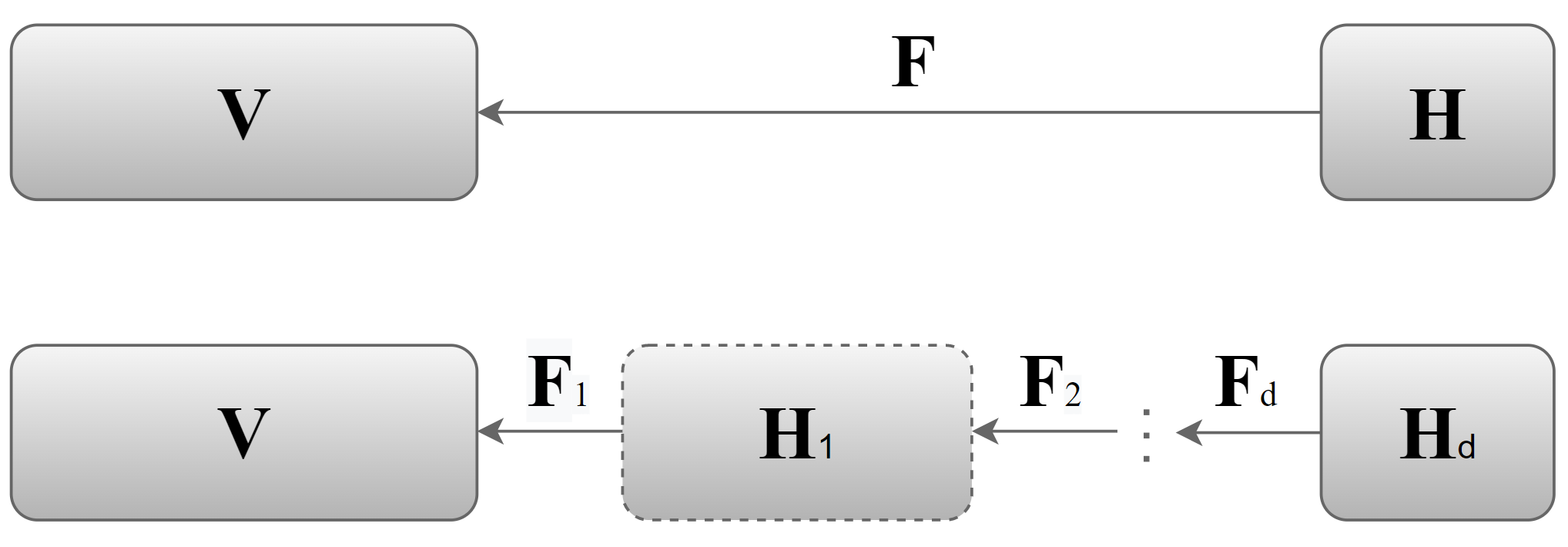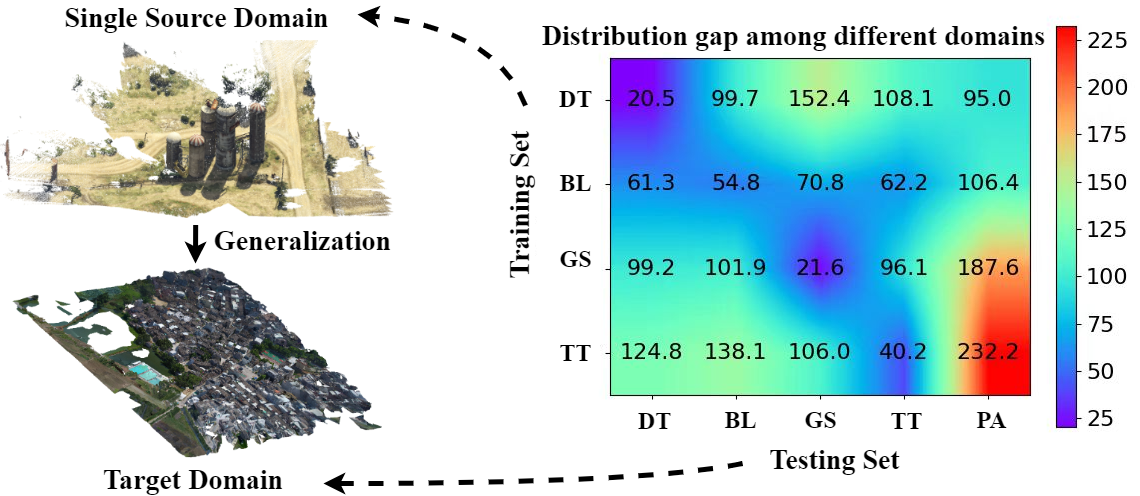Anchor-based Multi-view Subspace Clustering with Hierarchical Feature Descent
2310.07166

0
0

Abstract
Multi-view clustering has attracted growing attention owing to its capabilities of aggregating information from various sources and its promising horizons in public affairs. Up till now, many advanced approaches have been proposed in recent literature. However, there are several ongoing difficulties to be tackled. One common dilemma occurs while attempting to align the features of different views. {Moreover, due to the fact that many existing multi-view clustering algorithms stem from spectral clustering, this results to cubic time complexity w.r.t. the number of dataset. However, we propose Anchor-based Multi-view Subspace Clustering with Hierarchical Feature Descent(MVSC-HFD) to tackle the discrepancy among views through hierarchical feature descent and project to a common subspace( STAGE 1), which reveals dependency of different views. We further reduce the computational complexity to linear time cost through a unified sampling strategy in the common subspace( STAGE 2), followed by anchor-based subspace clustering to learn the bipartite graph collectively( STAGE 3). }Extensive experimental results on public benchmark datasets demonstrate that our proposed model consistently outperforms the state-of-the-art techniques.
Create account to get full access
Overview
- This paper presents a novel approach called "Anchor-based Multi-view Subspace Clustering with Hierarchical Feature Descent" for clustering data from multiple perspectives or "views".
- The key idea is to leverage "anchor points" to capture the underlying data structure and learn a shared subspace representation across different views.
- The method also incorporates a hierarchical feature descent strategy to progressively refine the feature representation, leading to more accurate clustering results.
Plain English Explanation
In many real-world applications, data can be observed from different perspectives or "views". For example, an image could be described by its visual features, textual captions, and metadata. Anchor-based Multi-view Subspace Clustering with Hierarchical Feature Descent aims to group this multi-view data into meaningful clusters.
The core insight is to find a few "anchor points" that can capture the essential structure of the data. These anchor points serve as reference points to learn a shared subspace representation that is common across the different views. By focusing on these anchor points, the method can more effectively discover the underlying clusters, even when the individual views are quite different.
Additionally, the approach uses a hierarchical feature descent strategy to progressively refine the feature representation. It starts with a coarse set of features and iteratively adds more detailed features, leading to increasingly accurate clustering results. This is akin to how humans might first get a high-level understanding of a scene and then focus on the finer details.
Overall, this anchor-based multi-view clustering technique with hierarchical feature refinement can be quite effective at uncovering meaningful groupings in complex, multi-faceted datasets. It has the potential to benefit a wide range of applications, from image analysis to hyperspectral imaging to recommender systems.
Technical Explanation
The key technical components of the "Anchor-based Multi-view Subspace Clustering with Hierarchical Feature Descent" approach are:
-
Anchor-based Multi-view Subspace Clustering: The method first identifies a set of "anchor points" that can capture the essential structure of the data across the different views. It then learns a shared subspace representation by aligning the data around these anchor points. This shared subspace enables more effective clustering compared to clustering each view independently.
-
Hierarchical Feature Descent: The approach starts with a coarse set of features and iteratively adds more detailed features through a hierarchical process. This allows the model to progressively refine the feature representation, leading to increasingly accurate clustering results.
-
Optimization Framework: The authors formulate an optimization problem that jointly learns the anchor points, the shared subspace, and the hierarchical feature representation. They develop an efficient alternating minimization algorithm to solve this optimization problem.
The experimental results demonstrate the effectiveness of this approach compared to state-of-the-art multi-view clustering methods on several real-world datasets, including image, text, and hyperspectral data.
Critical Analysis
The paper provides a comprehensive technical description of the proposed "Anchor-based Multi-view Subspace Clustering with Hierarchical Feature Descent" method and demonstrates its strong performance on various datasets. However, the authors do not extensively discuss the potential limitations or caveats of their approach.
One potential concern is the computational complexity of the optimization process, which involves iterative updates of the anchor points, subspace, and feature representation. This may limit the scalability of the method to large-scale datasets or real-time applications.
Additionally, the paper does not explore the sensitivity of the method to the choice of hyperparameters, such as the number of anchor points or the depth of the hierarchical feature descent. Further analysis of the robustness of the approach to these design choices would be valuable.
Another area for future research could be the extension of this method to handle dynamic or streaming data, where the data distribution may change over time. Investigating how the anchor-based multi-view clustering approach could be adapted to such scenarios would be an interesting direction to pursue.
Conclusion
This paper presents a novel "Anchor-based Multi-view Subspace Clustering with Hierarchical Feature Descent" method that effectively leverages the complementary information across multiple data views to discover meaningful clusters. By identifying anchor points and learning a shared subspace representation, the approach can capture the underlying data structure more accurately than clustering each view independently.
The hierarchical feature descent strategy further refines the feature representation, leading to improved clustering performance. The experimental results demonstrate the effectiveness of this approach on various real-world datasets, suggesting its potential to benefit a wide range of applications that involve multi-view data.
While the paper provides a solid technical foundation, additional research is needed to address potential limitations, such as computational complexity and sensitivity to hyperparameters. Exploring extensions to dynamic or streaming data environments could also be a fruitful area for future work.
This summary was produced with help from an AI and may contain inaccuracies - check out the links to read the original source documents!
Related Papers

One-Step Late Fusion Multi-view Clustering with Compressed Subspace
Qiyuan Ou, Pei Zhang, Sihang Zhou, En Zhu

0
0
Late fusion multi-view clustering (LFMVC) has become a rapidly growing class of methods in the multi-view clustering (MVC) field, owing to its excellent computational speed and clustering performance. One bottleneck faced by existing late fusion methods is that they are usually aligned to the average kernel function, which makes the clustering performance highly dependent on the quality of datasets. Another problem is that they require subsequent k-means clustering after obtaining the consensus partition matrix to get the final discrete labels, and the resulting separation of the label learning and cluster structure optimization processes limits the integrity of these models. To address the above issues, we propose an integrated framework named One-Step Late Fusion Multi-view Clustering with Compressed Subspace (OS-LFMVC-CS). Specifically, we use the consensus subspace to align the partition matrix while optimizing the partition fusion, and utilize the fused partition matrix to guide the learning of discrete labels. A six-step iterative optimization approach with verified convergence is proposed. Sufficient experiments on multiple datasets validate the effectiveness and efficiency of our proposed method.
5/29/2024

S^2MVTC: a Simple yet Efficient Scalable Multi-View Tensor Clustering
Zhen Long, Qiyuan Wang, Yazhou Ren, Yipeng Liu, Ce Zhu

0
0
Anchor-based large-scale multi-view clustering has attracted considerable attention for its effectiveness in handling massive datasets. However, current methods mainly seek the consensus embedding feature for clustering by exploring global correlations between anchor graphs or projection matrices.In this paper, we propose a simple yet efficient scalable multi-view tensor clustering (S^2MVTC) approach, where our focus is on learning correlations of embedding features within and across views. Specifically, we first construct the embedding feature tensor by stacking the embedding features of different views into a tensor and rotating it. Additionally, we build a novel tensor low-frequency approximation (TLFA) operator, which incorporates graph similarity into embedding feature learning, efficiently achieving smooth representation of embedding features within different views. Furthermore, consensus constraints are applied to embedding features to ensure inter-view semantic consistency. Experimental results on six large-scale multi-view datasets demonstrate that S^2MVTC significantly outperforms state-of-the-art algorithms in terms of clustering performance and CPU execution time, especially when handling massive data. The code of S^2MVTC is publicly available at https://github.com/longzhen520/S2MVTC.
4/12/2024

Multi-level Graph Subspace Contrastive Learning for Hyperspectral Image Clustering
Jingxin Wang, Renxiang Guan, Kainan Gao, Zihao Li, Hao Li, Xianju Li, Chang Tang

0
0
Hyperspectral image (HSI) clustering is a challenging task due to its high complexity. Despite subspace clustering shows impressive performance for HSI, traditional methods tend to ignore the global-local interaction in HSI data. In this study, we proposed a multi-level graph subspace contrastive learning (MLGSC) for HSI clustering. The model is divided into the following main parts. Graph convolution subspace construction: utilizing spectral and texture feautures to construct two graph convolution views. Local-global graph representation: local graph representations were obtained by step-by-step convolutions and a more representative global graph representation was obtained using an attention-based pooling strategy. Multi-level graph subspace contrastive learning: multi-level contrastive learning was conducted to obtain local-global joint graph representations, to improve the consistency of the positive samples between views, and to obtain more robust graph embeddings. Specifically, graph-level contrastive learning is used to better learn global representations of HSI data. Node-level intra-view and inter-view contrastive learning is designed to learn joint representations of local regions of HSI. The proposed model is evaluated on four popular HSI datasets: Indian Pines, Pavia University, Houston, and Xu Zhou. The overall accuracies are 97.75%, 99.96%, 92.28%, and 95.73%, which significantly outperforms the current state-of-the-art clustering methods.
4/9/2024

RobustMVS: Single Domain Generalized Deep Multi-view Stereo
Hongbin Xu, Weitao Chen, Baigui Sun, Xuansong Xie, Wenxiong Kang

0
0
Despite the impressive performance of Multi-view Stereo (MVS) approaches given plenty of training samples, the performance degradation when generalizing to unseen domains has not been clearly explored yet. In this work, we focus on the domain generalization problem in MVS. To evaluate the generalization results, we build a novel MVS domain generalization benchmark including synthetic and real-world datasets. In contrast to conventional domain generalization benchmarks, we consider a more realistic but challenging scenario, where only one source domain is available for training. The MVS problem can be analogized back to the feature matching task, and maintaining robust feature consistency among views is an important factor for improving generalization performance. To address the domain generalization problem in MVS, we propose a novel MVS framework, namely RobustMVS. A DepthClustering-guided Whitening (DCW) loss is further introduced to preserve the feature consistency among different views, which decorrelates multi-view features from viewpoint-specific style information based on geometric priors from depth maps. The experimental results further show that our method achieves superior performance on the domain generalization benchmark.
5/16/2024